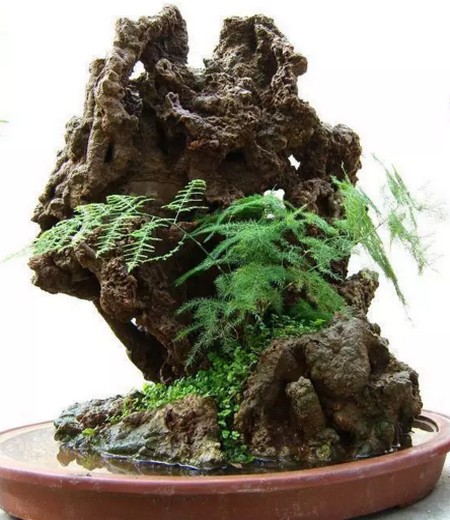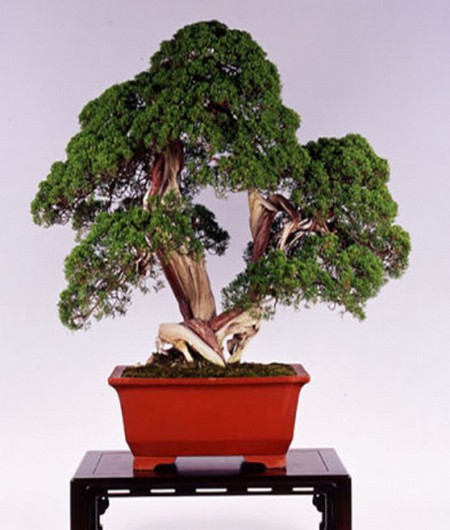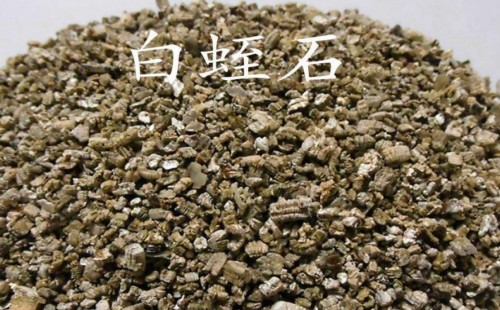A brief introduction to the bonsai plants of Sheung Shui Stone (absorbent Stone) understanding the habits of plants
The performance of Shangshui stone is strong. After storing water in the basin, it can be sucked to the top instantly. Stone can plant weeds, moss moss, green and moist, for the production of bonsai stone. Sand stone, pleasanting and brittle, but strong water absorption; limestone has slightly higher hardness and finer structure than sand stone. Sheung Shui stone is easy to shape, because of pleasantries and brittle, you can chisel grooves, drill holes and carve out the ideal image in your heart.

There are many large and small natural caves on the Sheung Shui stone, some of which are connected to each other, and small caves such as stomata, which is the main reason for strong water absorption. In the caves on the stone in Sheung Shui, flowers and plants can be planted with soil, and trees can be planted in large caves. due to the strong water absorption of the stone, the plants grow luxuriantly and bloom brightly. Sheung Shui stone can emit moisture, and using it to make rockery or bonsai has the effect of wetting the environment.
Sheung Shui stone fossils of ancient bryozoans date back to about 130 million to 190 million years ago. The stone is hard, yellow, brown, white and other colors, the appearance is beautiful and colorful, most of them are tubular, hollow, striped, unique. Hillsides and valleys are distributed, belonging to limestone, high-quality texture.
Which plants are suitable for the growth of Sheung Shui stone in bonsai?
(1) coriander
Also known as broken money grass, ground light money grass. It is a small perennial evergreen herb of Umbelliferae, with slender stems, creeping ground, leaves and roots on nodes. The leaf kidney is round, with lobes and teeth on the edge, shining above, and hanging from the rocks, which is very picturesque.
(2) Saxifraga
Alias Jinsi lotus leaf. Belongs to Saxifragaceae, perennial evergreen herbs. Simple leaves, base clustered, long stalked, creeping fine filiform, reddish purple, the tip of the branch can grow seedlings, can climb on the soil, stone, stone crevice, better on the waterside stone.
(3) Dryopteris
Also known as clematis. It is a perennial herb of Pteridaceae. Petiole thin and long, glossy, nearly black, leaf blade ovate triangular, 10-25 cm long, bipinnately compound leaves below the middle, lobules alternate.
(4) Artemisia angustifolia
It is a 1-year-old or 2-year-old plant of Caryophyllaceae. Stems mostly clustered, slightly scattered, leaves opposite linear, base slightly into a short sheath, white florets in spring. Born in Tianwen roadside meadows or mountains.
(5) Elaeagnus officinalis
Also known as acid pulp grass, for the sorrel grass family, perennial herbs. Stems and leaves contain oxalic acid and have a sour taste. Compound leaves, inverted heart-shaped, connate into a large leaf, bright green, open during the day and close at night. The stem is soft and easy to lodge. The flowers are white, yellow, red and so on.
(6) Acorus calamus
- Prev

A brief introduction to the bonsai of common family trees to master the methods of quickly understanding plants
The placement of tree stump bonsai should also be determined according to the characteristics of tree species. Generally, it should be placed in a ventilated and transparent place with a certain space humidity, insufficient sunlight, poor ventilation and no certain space humidity, which can make the plant yellow and dry, leading to the occurrence of diseases and insect pests until death.
- Next

What is vermiculite? how to distinguish the body characteristics of plants?
Potted friends who like to grow flowers and plants in pots generally come into contact with or use vermiculite, especially when growing succulent plants, the frequency of vermiculite is very high. So, what is vermiculite? Why is it favored by the majority of friends? Today, the editor is
Related
- What if the leaves of potted flowers turn yellow?
- Florescence Control of several Flowers
- Anti-freezing technology and post-freezing nursing technology of flowers
- What is the classification of flowers? What are the common methods of flower classification?
- Prevention and control of alkali and acid damage of flowers in courtyard
- Technology of Anti-freezing and restoring growth of Flower seedlings in greenhouse and greenhouse
- How does flower fertilization not hurt the root? Fertilization technology of flowers
- Key points of disinfection in flower greenhouse
- Several pesticides that are banned or used cautiously in flowers
- How to fertilize the flowers that watch the leaves?

